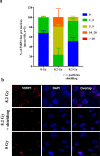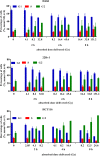Radiobiological effects of the alpha emitter Ra-223 on tumor cells
- PMID: 31811257
- PMCID: PMC6898438
- DOI: 10.1038/s41598-019-54884-7
Radiobiological effects of the alpha emitter Ra-223 on tumor cells
Abstract
Targeted alpha therapy is an emerging innovative approach for the treatment of advanced cancers, in which targeting agents deliver radionuclides directly to tumors and metastases. The biological effects of α-radiation are still not fully understood - partly due to the lack of sufficiently accurate research methods. The range of α-particles is <100 μm, and therefore, standard in vitro assays may underestimate α-radiation-specific radiation effects. In this report we focus on α-radiation-induced DNA lesions, DNA repair as well as cellular responses to DNA damage. Herein, we used Ra-223 to deliver α-particles to various tumor cells in a Transwell system. We evaluated the time and dose-dependent biological effects of α-radiation on several tumor cell lines by biological endpoints such as clonogenic survival, cell cycle distribution, comet assay, foci analysis for DNA damage, and calculated the absorbed dose by Monte-Carlo simulations. The radiobiological effects of Ra-223 in various tumor cell lines were evaluated using a novel in vitro assay designed to assess α-radiation-mediated effects. The α-radiation induced increasing levels of DNA double-strand breaks (DSBs) as detected by the formation of 53BP1 foci in a time- and dose-dependent manner in tumor cells. Short-term exposure (1-8 h) of different tumor cells to α-radiation was sufficient to double the number of cells in G2/M phase, reduced cell survival to 11-20% and also increased DNA fragmentation measured by tail intensity (from 1.4 to 3.9) dose-dependently. The α-particle component of Ra-223 radiation caused most of the Ra-223 radiation-induced biological effects such as DNA DSBs, cell cycle arrest and micronuclei formation, leading ultimately to cell death. The variable effects of α-radiation onto the different tumor cells demonstrated that tumor cells show diverse sensitivity towards damage caused by α-radiation. If these differences are caused by genetic alterations and if the sensitivity could be modulated by the use of DNA damage repair inhibitors remains a wide field for further investigations.
Conflict of interest statement
Authors #1, 3, 4, 5, 6 and 7 are employees of Bayer A.G. Authors #4, 5 and 6 hold stocks of Bayer A.G. Author #2 has received funding from Bayer A.G. Kristina Bannik is employed by Bayer A.G. Balázs Madas’s work was supported by Bayer A.G. Marco Jarzombek is employed by Bayer A.G. Andreas Sutter owns stock in Bayer A.G. and is employed by Bayer A.G. Gerhard Siemeister owns stock in Bayer A.G. and is employed by Bayer A.G. Dominik Mumberg owns stock in Bayer A.G. and is employed by Bayer A.G. Sabine Zitzmann-Kolbe is employed by Bayer A.G.
Figures







References
Publication types
MeSH terms
Substances
LinkOut - more resources
Full Text Sources

